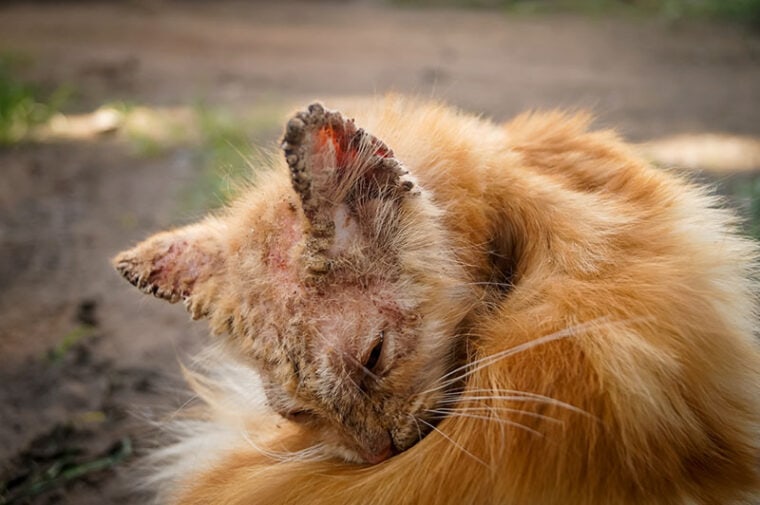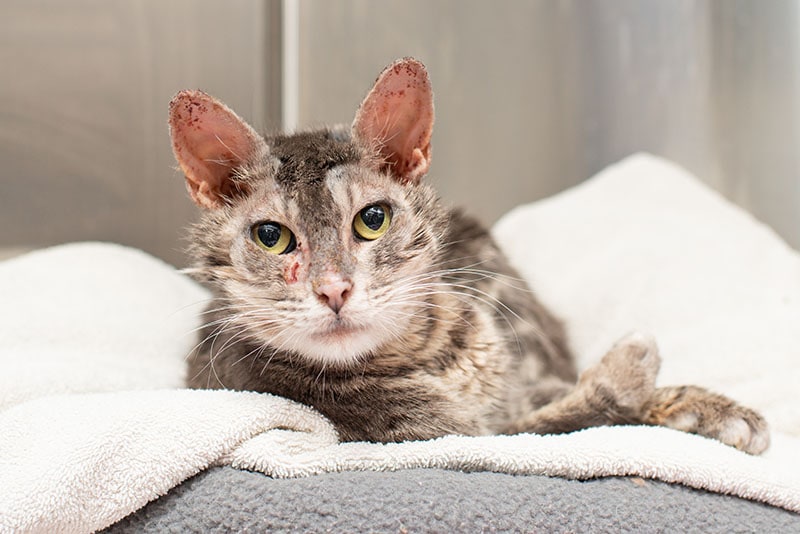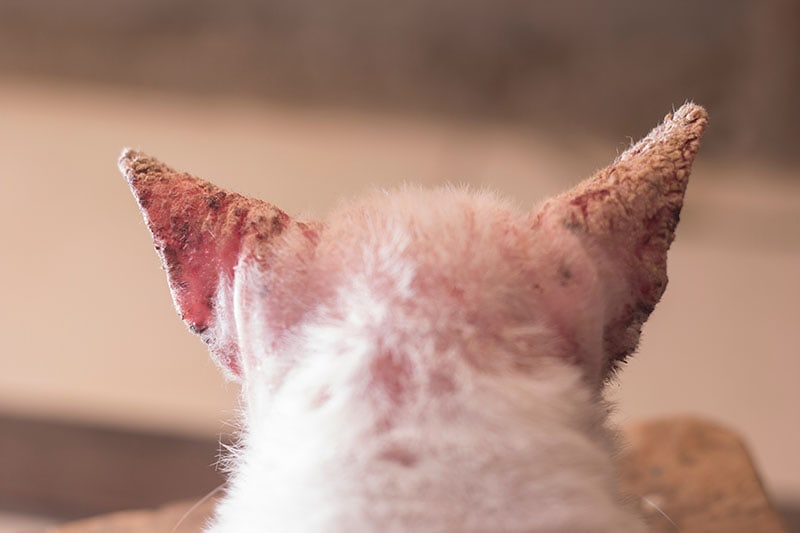
Mange in cats is a disease of the skin. It is caused by microscopic mites that burrow into the surface of the skin. The skin loses hair and becomes thick and crusty. It is extremely itchy, and cats often scratch themselves so much they cause self-inflicted trauma—scratches and sores.
What Is Mange?
Microscopic insects—mites—that live their whole lives on the skin of cats digging tunnels into the surface of the skin to eat, poop, and lay eggs, called Notoedres cati. The skin has an inflammatory response to the mites, making it itchy.
What Are the Signs of Mange?
Mange causes the skin to thicken, form crusts, and lose hair. It usually starts around the ears, spreads to the face, and then to the neck. In some cases, the feet and belly become infected because cats lay curled with their face touching their feet and belly.
What Are the Causes of Mange?
The mite that infests cats is called Notoedres cati. The condition is called mange but can sometimes be mistakenly called scabies. Scabies is the same condition, but in dogs, it is caused by a mite closely related called Sarcoptes scabiei.
The mites can cause secondary bacterial or yeast skin infections. As the mites dig their burrows, they break down the integrity of the skin barrier, leaving it exposed to bacteria and yeast.

How Do I Care for a Cat With Mange
There are several veterinary medications that treat mange. The most common is a family of drugs related to ivermectin, an anti-parasitic drug. Depending on the formula, it can be given by mouth, injected, or a small dot of it can be smeared on the skin—a spot-on.
Bathing a cat does not kill the mites unless it is with a cat-safe lime sulfur treatment. It can help the skin look and feel better after the mites are killed, and it can help treat secondary yeast and bacterial infections. But without medical treatment, the mites will not be killed and will continue to cause damage.
Many of the monthly spot-ons medications that treat and prevent fleas also treat and prevent mange.
Frequently Asked Questions (FAQs)
Is it contagious?
Notoedres cati is very contagious and spreads from cat to cat by direct contact—a nose-to-nose type situation. The mites can’t live off the skin, but they don’t die instantly—they can survive for a short time, hours, for example. So, in cases of severe infestation, a cat can pick it up from the environment.
For example, if a cat lays in a box overnight and then another cat comes along immediately afterward and lays in the same box, it could catch mange. This is why it is important to do a deep clean when you treat your cat; give it the medication and clean it.
Can Notoedres cati spread to other animals?
Notoedres cati can infect other animals, like dogs and even people, but it rarely does. It usually prefers cats but will infect other species if the infestation is severe enough. Usually, if the cat is treated and it goes away, then it also goes away in other animals on its own—it is usually self-limiting in other species.
Why does only one of my cats have mange?
You would think that because it is so contagious that if one cat suffers from manage, then they all would. But just because one cat has signs of it and the others do not does not mean there isn’t an infestation. Each cat will have an individual response—based on how many mites they carry and how sensitive/allergic they are to the mites.
It is common for one cat to have a flair-up while the other cats remain mostly normal. For one reason or another, the cats without signs of mites have them in their skin but do not show signs of infestation.
This is why all cats in the house need to be treated at the same time to get rid of it. If you treat your cat for mange and it does not go away, it is probably getting it from other cats that do not have signs of it.

What happens if it’s not treated?
In severe cases, the skin thickens and becomes sorer, the legs can swell, and it can cause cats to starve and become emaciated. If it becomes severe enough, cats can die from mange, especially if there are also fleas and infections, creating a perfect storm of trouble.
How is it diagnosed?
If you suspect mange, bring your cat to the vet for a diagnosis. Expect them to take a skin sample that they will examine under the microscope looking for the mites.
As you can imagine, it can be difficult to catch the perfect sample of skin with mites stuck to it. It can be difficult to find the mites—there is a lot of skin for them to hide on. So, sometimes a vet will not be able to find evidence of the mites but will still give the medication, especially if the signs all point to manage. This is called a therapeutic trial. Because the medications are so safe and have the added benefit of treating fleas and other parasites, they usually helps.
How do I know if my cat is very itchy?
They will scratch their ears or face dozens of times a day. Two or three good healthy scratches are normal for a cat.
And especially because they groom themselves, it can be hard to tell when a cat is over-scratching itself but a cat with mange will scratch their face dozens of times a day. Sometimes they will scratch themselves, stand up to move on, and then suddenly sit and scratch themselves again.
Sometimes they will not let you pet their head or flinch when you go in for a pet, but sometimes they will love it when you do the scratching for them. A cat that leans into your scratches is normal; a cat that falls over-leaning into your scratches is too much—usually.
Conclusion
Luckily, mange is not as common in our house cats as it used to be because most cats are being given preventative treatment for it through their flea treatments. But, in stray cats, mange can be quite common, especially in warm climates.
So, I hope you don’t feel too itchy now, but thanks for learning more about notoedric mange in cats.
Featured Image Credit: Suharji Esha, Shutterstock







